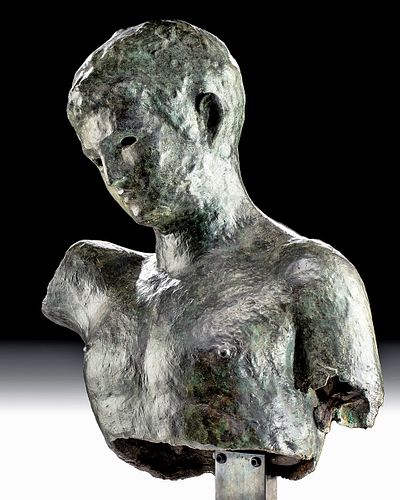Published Greek Hellenistic Bronze Head / Torso
Lot 27a
About Seller
Artemis Fine Arts
686 S Taylor Ave, Ste 106
Louisville, CO 80027
United States
Selling antiquities, ancient and ethnographic art online since 1993, Artemis Gallery specializes in Classical Antiquities (Egyptian, Greek, Roman, Near Eastern), Asian, Pre-Columbian, African / Tribal / Oceanographic art. Our extensive inventory includes pottery, stone, metal, wood, glass and textil...Read more
Estimate:
$70,000 - $100,000
Absentee vs Live bid
Two ways to bid:
- Leave a max absentee bid and the platform will bid on your behalf up to your maximum bid during the live auction.
- Bid live during the auction and your bids will be submitted real-time to the auctioneer.
Bid Increments
| Price | Bid Increment |
|---|---|
| $0 | $25 |
| $300 | $50 |
| $1,000 | $100 |
| $2,000 | $250 |
| $5,000 | $500 |
| $10,000 | $1,000 |
| $20,000 | $2,500 |
| $50,000 | $5,000 |
| $100,000 | $10,000 |
| $200,000 | $20,000 |
About Auction
By Artemis Fine Arts
Feb 13, 2020
Set Reminder
2020-02-13 10:00:00
2020-02-13 10:00:00
America/New_York
Bidsquare
Bidsquare : Exceptional Antiquities, Asian, Ethnographic
https://www.bidsquare.com/auctions/artemis-gallery/exceptional-antiquities-asian-ethnographic-4848
An important one-day auction featuring museum-worthy examples of Egyptian, Greek, Roman, Etruscan, Near Eastern, Far East / Asian, Pre-Columbian, African / Tribal, Oceanic, Native American, Spanish Colonial, Russian, Fossils, Ancient Jewelry, Fine Art, so much more! Artemis Fine Arts info@artemisfinearts.com
An important one-day auction featuring museum-worthy examples of Egyptian, Greek, Roman, Etruscan, Near Eastern, Far East / Asian, Pre-Columbian, African / Tribal, Oceanic, Native American, Spanish Colonial, Russian, Fossils, Ancient Jewelry, Fine Art, so much more! Artemis Fine Arts info@artemisfinearts.com
- Lot Description
Greece, Late Hellenistic, ca. 1st century BCE to 1st century CE. A rare and magnificent bronze sculpture of the head and torso belonging to a male youth, raising his right arm and captured in the act of crowning himself with a victory wreath. This interpretation comes to us, because the figure was modeled after the late 5th century BCE statue of the victorious athlete Kyniskos (also Cyniscus) by Polykleitos (5th century BCE) which is perhaps best known for the marble version in the British Museum called the Westmacott Athlete after its former owner, Sir Richard Westmacott, R.A. (1775-1856). Notice how the figure's thorax is stretched to the right as the figure raises his right arm, presenting a rhythmic sense of motion that suggests lifelike energy, certainly a calculated pose intended to conjure human vitality in sculpture for which Polykleitos set the standard. Size: 12" W x 13.75" H (30.5 cm x 34.9 cm); 19.5" H (49.5 cm) on included custom stand.
The athlete's visage is a youthful countenance with openwork eyes that once held inlays, delineated brows, a nose that is modest in scale, closed heart-shaped lips with a delineated philtrum above, a pointed chin, soft facial contours, and naturalistic ears - all crowned by a full head of closely cropped wavy hair.
This type is referred to as the Westmacott Athlete after the British Museum's version (1857,0807.1) of Polykleitos' original bronze, ca. 440 BCE, so named as it was formerly of the Westmacott collection. During the excavations at Olympia some versions of this figure were discovered bearing the signature of Polykleitos. Scholars believe that Polkleitos represented a champion boxer placing the victory wreath on his head.
Polykleitos, considered one of the most important sculptors of the Classical World, along with Phidias (488-431 BCE) and Myron (480-444 BCE), was known for writing his treatise (Kanon) which described the methods and principles for designing the perfect statue of a human figure known as the Kanon of Polykleitos. The Kanon of Polykleitos exalted a newfound counterbalance of tension and relaxation in the figure, particularly through movement of the shoulder and hips, known as chiastic balance, as well as symmetry. Polykleitos declared that a statue should be composed of defined parts that are related via a system of balance and ideal mathematical proportions which were expressed it in terms of Pythagorean ratios. His theories would set the standard proportions for sculptors throughout art history.
Published: J. Eisenberg, "Gods and Mortals II," 2004, no. 37.
Provenance: private New York, New York, USA collection, acquired from Piasa, Paris, France (October 1-2, 2003, lot 370); ex-private Paris, France collection, acquired in the 1950s
All items legal to buy/sell under U.S. Statute covering cultural patrimony Code 2600, CHAPTER 14, and are guaranteed to be as described or your money back.
A Certificate of Authenticity will accompany all winning bids.
We ship worldwide and handle all shipping in-house for your convenience.
#152697A section from a larger sculpture with losses to peripheries as shown. Eyes were once inlaid. Figure has areas of central chest showing restoration and repatination. Several repairs as is normal for a bronze of this size.Condition
- Shipping Info
-
All shipping is handled in-house for your convenience. Your invoice from Artemis Gallery will include shipping calculation instructions. If in doubt, please inquire BEFORE bidding for estimated shipping costs for individual items.
-
- Buyer's Premium



 EUR
EUR CAD
CAD AUD
AUD GBP
GBP MXN
MXN HKD
HKD CNY
CNY MYR
MYR SEK
SEK SGD
SGD CHF
CHF THB
THB















